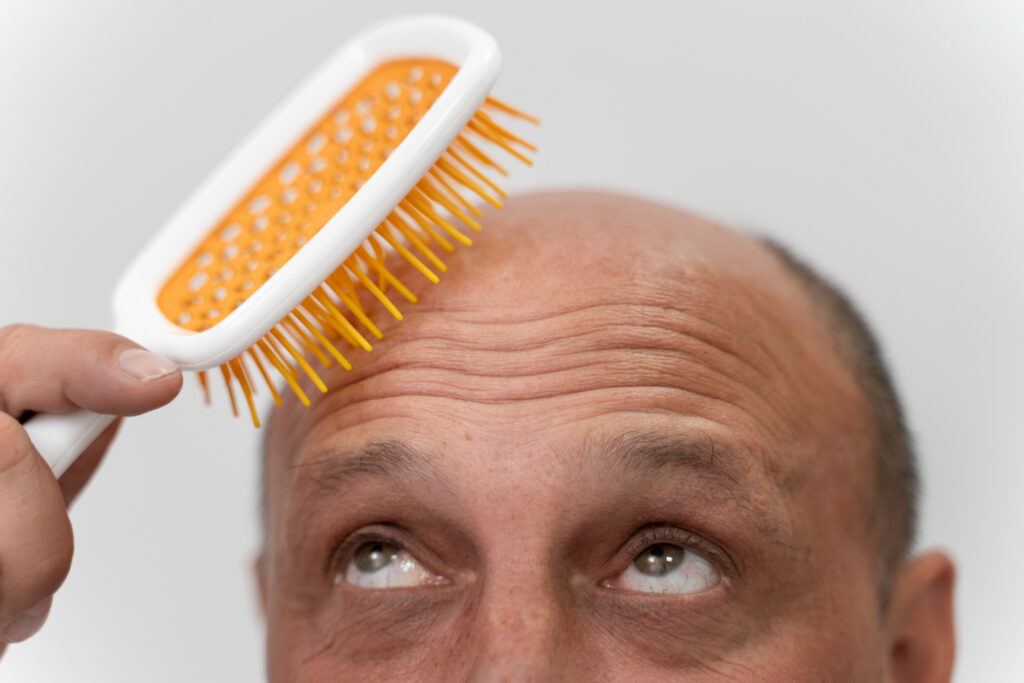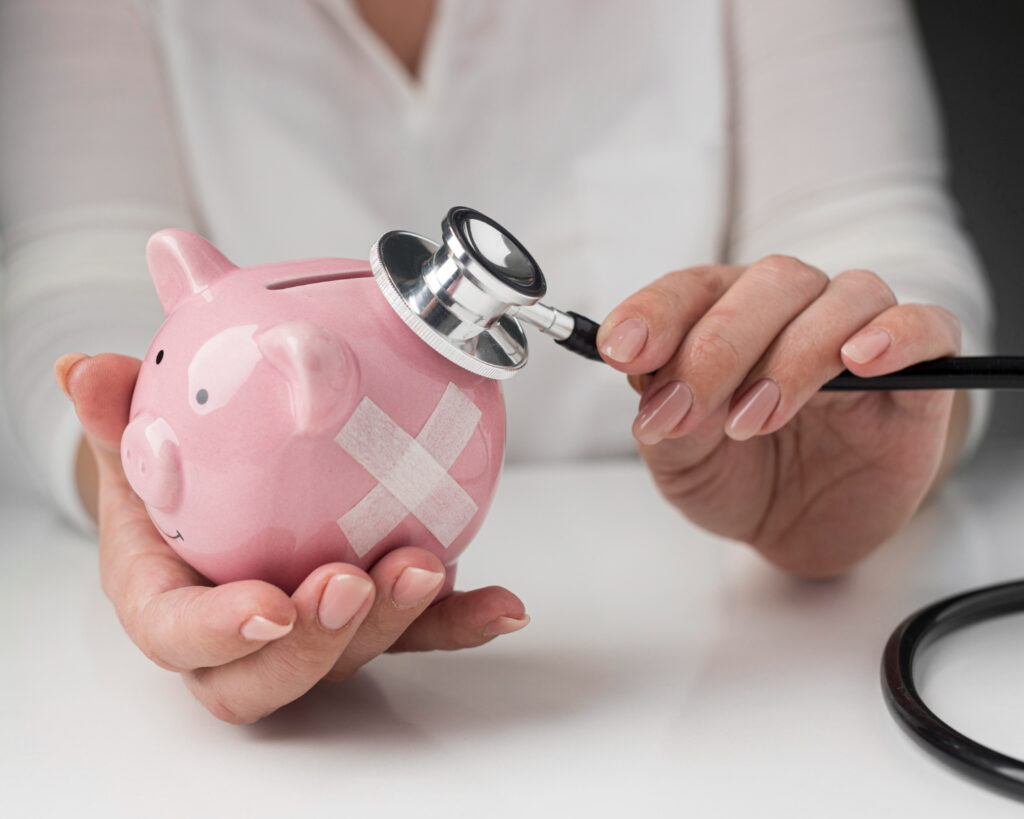Your mirror doesn’t lie. Neither does your shower drain. Those extra strands you’re finding everywhere aren’t just in your imagination—but the real cause might not be what you think.
While most people immediately blame genetics or aging for their thinning hair, there’s a silent saboteur that could be the actual culprit: the dangerous dance between chronic stress and poor sleep quality.
This isn’t just another internet theory. The connection between your mental state, sleep patterns, and hair health forms a triangle that millions of Americans are unknowingly caught in. Let’s pull back the curtain on this hidden relationship that could be costing you your crowning glory.
The Modern Hair Loss Epidemic Nobody’s Talking About
Josh knew something was wrong when his barber of eight years finally mentioned it: “Man, your hair’s really thinned out since your promotion, huh?”
That casual observation hit harder than any performance review. As a 34-year-old tech executive, Josh had been pulling 70-hour weeks and averaging maybe five hours of broken sleep per night. His hair loss seemed to accelerate exactly when his responsibilities—and stress levels—skyrocketed.
“I figured it was just my dad’s genes finally catching up with me,” Josh shares. “I never connected it to the fact that I was constantly wired, checking emails at 2 AM, and surviving on energy drinks.”
Josh isn’t alone. According to recent surveys, nearly 60% of Americans report higher stress levels than five years ago, and over 35% regularly get less than the recommended seven hours of sleep. Coincidentally (or not), hair care forums and social media groups dedicated to hair loss have seen membership surge by over 300% in the same period.
The Science of Your Stressed-Out Strands: Why It’s Not “Just In Your Head”
When your body feels threatened—whether by a looming work deadline, relationship troubles, or financial pressure—it doesn’t distinguish between these modern stressors and the prehistoric threat of a predator. Your system responds the same way: by shifting into survival mode.
The Stress Response That’s Sabotaging Your Scalp
When stress becomes your default state, your body makes executive decisions about resource allocation. Simply put: maintaining your lustrous locks becomes a luxury your body can’t afford when it thinks it’s constantly fighting for survival.
Here’s what’s really happening under your scalp:
- The Cortisol Connection: Persistent stress triggers elevated cortisol—your body’s primary stress hormone. This disrupts your hair’s natural growth cycle by pushing follicles from the active growing phase (anagen) into the resting phase (telogen) prematurely.
- Inflammation Amplification: Chronic stress creates system-wide inflammation, including in your scalp tissue. This inflammatory response can directly damage hair follicles and create an inhospitable environment for healthy growth.
- Blood Flow Restriction: During stress responses, your body prioritizes blood flow to essential organs, potentially limiting circulation to your scalp. Less blood means fewer nutrients reaching your hair follicles.
- Stress-Triggered Behaviors: Let’s be honest—when you’re stressed, your self-care often takes a nosedive. Stress eating (often nutrient-poor choices), increased alcohol consumption, and skipping exercise all indirectly impact hair health.
The Sleep Deficit That’s Draining Your Follicles
If stress is the match, poor sleep is the gasoline that turns hair thinning into a five-alarm fire. Here’s how inadequate sleep amplifies the problem:
- Growth Hormone Deficiency: Your body releases up to 70% of its daily growth hormone production during deep sleep. This hormone is crucial for cellular repair—including the cells that grow your hair.
- Melatonin Disruption: Beyond regulating sleep, melatonin acts as a powerful antioxidant that protects hair follicles from oxidative stress. Sleep disruption means less melatonin production.
- Protein Synthesis Problems: Hair is primarily made of protein (keratin), and much of your body’s protein synthesis happens during sleep. Cut sleep short, and you’re literally cutting off the building blocks your hair needs.
- The Sleep-Stress Cycle: Perhaps most insidiously, poor sleep increases your sensitivity to stress, while increased stress makes quality sleep more elusive—creating a vicious cycle that’s reflected in your thinning hairline.
Emma, a 29-year-old consultant who experienced noticeable shedding after a particularly demanding project, describes this perfectly: “It was like watching my stress levels manifest physically in my brush each morning. The less I slept, the more hair I lost, which stressed me out even more—and made sleeping even harder.”
Breaking the Triangle: Evidence-Based Strategies That Actually Work
The good news? This form of hair thinning is often reversible once you address the underlying stress-sleep connection. The better news? You can start implementing changes today.
1. Stress Management That Fits Real Life (Not Instagram)
Forget the picture-perfect meditation retreats. These practical approaches work for actual humans with busy lives:
▶ Tactical Breathing for Immediate Relief
When stress spikes, your breathing pattern changes, triggering more stress hormones. Breaking this cycle takes just 90 seconds:
- Try the 4-7-8 technique: Inhale for 4 counts, hold for 7, exhale for 8
- Practice this 2-3 times during predictable stress points in your day (before checking email, entering meetings, starting your commute)
- Use a smart watch or phone reminder to prompt regular breathing breaks
▶ Micro-Movement to Process Stress Hormones
Stress hormones were designed to be metabolized through physical movement:
- Schedule 5-minute movement breaks every 90 minutes of sedentary work
- Try desk-friendly tension relievers: shoulder rolls, gentle neck stretches, or simply standing and gently twisting at the waist
- Consider a midday walk—research shows even 10 minutes of walking can significantly lower cortisol levels
▶ Psychological Boundaries That Actually Hold
Many stress management techniques fail because they don’t address the underlying sources of pressure:
- Audit your digital notifications and disable all non-essential alerts
- Establish clear communication about your availability (and unavailability)
- Create transition rituals between work and personal time (a specific playlist, a brief walk, changing clothes)
- Consider using “worry scheduling”—setting aside a specific 15-minute block to process concerns rather than letting them invade your entire day
▶ Nutritional Support for Your Stress Response System
What you eat directly impacts how your body handles stress:
- Focus on complex carbs (sweet potatoes, whole grains) to support steady serotonin production
- Include omega-3 sources (walnuts, flaxseeds) which have been shown to moderate stress responses
- Consider magnesium-rich foods (dark leafy greens, pumpkin seeds) which support stress recovery
- Stay hydrated—even mild dehydration amplifies stress hormone production
2. Sleep Optimization Beyond the Basics
You know you need 7-9 hours of sleep. Here’s how to actually make that happen in the real world:
▶ Engineer Your Sleep Environment for Success
Your bedroom should be a sleep sanctuary:
- Invest in blackout curtains or a quality sleep mask (light exposure as small as 1 lux can disrupt sleep rhythms)
- Keep your sleeping space between 65-68°F (18-20°C)—the temperature range proven to support optimal sleep
- Consider a white noise machine to mask unpredictable sounds that trigger stress responses during sleep
- Remove visible clocks—checking the time when you wake at night increases sleep anxiety
▶ Develop a Wind-Down Sequence That Signals Your Brain
Your brain needs transition time between daytime alertness and sleep readiness:
- Create a consistent 30-minute pre-sleep routine that your body begins to recognize as a sleep signal
- Try the 3-2-1 method: 3 hours before bed, finish eating; 2 hours before, finish work; 1 hour before, no screens
- Use sleep-specific breathing patterns: 4-count inhale through nose, 7-count exhale through mouth
- Consider sleep-promoting stretches like gentle forward folds, child’s pose, or legs up the wall
▶ Harness Light Exposure for Better Sleep-Wake Cycles
Strategic light management regulates your sleep hormones:
- Get 10-20 minutes of morning sunlight exposure to properly set your circadian rhythm
- Use amber-tinted glasses in the evening to block sleep-disrupting blue light
- Install dimmer switches or use low-wattage lamps for evening activities
- Keep your bedroom completely dark during sleep hours
▶ Address Common Sleep Disruptors Head-On
Identify and tackle the specific issues undermining your sleep quality:
- If racing thoughts keep you awake, try a “brain dump” journal before bed
- If temperature fluctuations disrupt your sleep, consider layered bedding you can adjust
- If a partner’s movements wake you, explore memory foam mattress toppers or separate blankets
- If you wake to use the bathroom, limit fluids 2-3 hours before bed
3. Hair-Friendly Habits That Support Recovery
While addressing stress and sleep, implement these habits to create optimal conditions for hair regrowth:
▶ Nutrition That Feeds Your Follicles
Hair is primarily protein, requiring specific nutrients to thrive:
- Ensure adequate protein intake (roughly 0.8g per kg of body weight daily)
- Include iron-rich foods paired with vitamin C for better absorption
- Don’t overlook zinc (pumpkin seeds, lentils) and selenium (brazil nuts, yellowfin tuna) which support the hair growth cycle
- Stay consistently hydrated—dehydration quickly impacts hair texture and growth
▶ Physical Care That Preserves Vulnerable Strands
Minimize additional stress to fragile hair:
- Switch to a wide-tooth wooden comb instead of brushes
- Avoid hairstyles that create tension at the roots
- Consider washing less frequently (2-3 times weekly) to preserve natural oils
- Use cooler water temperatures when washing to reduce scalp inflammation
▶ Scalp Care That Creates Optimal Growing Conditions
A healthy scalp is the foundation for hair recovery:
- Try gentle massage techniques to stimulate blood flow (2-3 minutes daily)
- Consider weekly scalp exfoliation to remove buildup that can block follicles
- Explore natural scalp soothers like aloe vera or tea tree oil for inflammation
- Protect your scalp from sun exposure, which can damage follicles
The Recovery Timeline: Setting Realistic Expectations
Hair growth follows its own timeline, regardless of how urgently you want results. Understanding the recovery process can help manage expectations:
First 1-2 months: Focus on stress reduction and sleep improvement. Visible hair changes will be minimal during this foundation-building phase.
Months 3-6: You may notice reduced shedding first, rather than new growth. Look for “baby hairs” around your hairline or part.
Months 6-12: With consistent habits, more noticeable improvements in density typically appear. New growth will gradually thicken and strengthen.
Beyond 12 months: For significant stress-related hair loss, full recovery can take up to 18 months of consistent habit change.
Tyler, who reversed his stress-related hair loss, shares: “The hardest part was patience. I wanted immediate results, but my hair took its time. Around month five, my girlfriend noticed fuzz at my temples. By month nine, my barber commented on how much thicker my hair felt. But it was a full year before I really felt confident about the improvement.”
When to Consider Additional Support
While lifestyle changes can dramatically impact stress-related hair thinning, sometimes you need extra assistance:
- If hair loss continues unabated despite 3+ months of improved sleep and stress management
- If you notice other health changes alongside hair loss
- If your hair loss pattern is unusual (patchy rather than diffuse)
- If family history suggests other factors may be involved
The Takeaway: Your Hair Is Your Body’s Honest Messenger
Your hair doesn’t just reflect your styling preferences—it’s a visible barometer of your internal wellbeing. The strands you’re finding on your pillow might actually be your body’s way of waving a red flag about your stress levels and sleep quality.
By addressing these foundational issues, you’re not just saving your hair—you’re reclaiming your overall health from the ground up. The most powerful “hair growth formula” might not come in a bottle, but in the form of proper rest and a calmer mind.
Remember: Those who successfully reverse stress-related hair thinning don’t just regain their hair—they often discover a more balanced, sustainable approach to life that benefits every aspect of their health.
Your journey to healthier hair might just lead you to a healthier life overall. And that’s worth far more than just a good hair day.

Disclaimer: This article is intended for informational purposes only and does not constitute medical advice. The information provided is not intended to diagnose, treat, cure, or prevent any condition. Always consult with a qualified healthcare provider regarding any questions about your health or before starting any new supplement or wellness routine. Hair thinning can have many causes, including conditions that require professional evaluation. The experiences shared in this article are examples and individual results may vary.
Sources: American Academy of Dermatology, Sleep Foundation, Harvard Health Publishing, International Journal of Trichology, Cleveland Clinic



